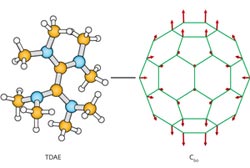The origin of organic magnets

A compound comprising C60 (right), a spherical molecule of carbon atoms, and TDAE (left), tetrakis-dimethylamino-ethylene, is unusual because it can display magnetic behavior at low temperatures. Copyright : 2012 Tohru Sato<br>
Electrical engineers are starting to consider materials made from organic molecules—including those made from carbon atoms—as an intriguing alternative to the silicon and metals used currently in electronic devices, since they are easier and cheaper to produce.
A RIKEN-led research team has now demonstrated the origin of magnetism in organic molecules1, a property that is rarely found in this class of material, but is vital if a full range of organic electronic devices is to be created.
The permanent magnetic properties of materials such as iron stem from an intrinsic mechanism called ferromagnetism. Ferromagnetism in organic materials is rare because their atomic structure is fundamentally different from metals. One of the few examples identified to date is called TDAE-C60: a compound comprising spherical carbon cages attached to an organic molecule known as tetrakis-dimethylamino-ethylene. Since its identification in 1991, many theoretical and experimental studies have provided some insight into the mechanism driving this unexpected ferromagnetism, but the explanation was not definitive.
A full understanding would help materials scientists to develop more advanced magnetic materials in the future. “A precise model for organic magnetism could aid the design of high-density recording materials for use in next-generation memories,” says team member Hitoshi Yamaoka from the RIKEN SPring-8 Center, Harima.
Materials scientists are particularly interested in understanding the electronic structure of TDAE-C60 and how this relates to its ferromagnetic properties. To this end, Yamaoka and his colleagues from research institutes across Japan studied this material using a powerful technique known as photoelectron spectroscopy (PES). They fired x-rays at a single crystal of TDAE-C60, and this radiation excited electrons in the crystal, which then escaped from the surface. The researchers measured the number and the kinetic energy of these electrons from which they could infer information about the electronic structure.
“From these experiments on a single crystal we could establish an exact theoretical model for organic magnetism,” explains Yamaoka. “We propose that the transfer of one electron from the TDAE to the C60 causes the magnetic properties of TDAE-C60.” The existence of the resulting positively charge TDAE state was also supported by the team’s theoretical calculations.
With this thorough understanding of organic magnetism, the next step will be to apply the material to practical applications. “The problem with the TDAE-C60 organic magnet, however, is that the magnetism only appears at temperatures below 16 kelvin,” says Yamaoka. “The next step will be to raise this transition point.”
The corresponding author for this highlight is based at the Coherent X-Ray Optics Laboratory, RIKEN SPring-8 Center
Media Contact
All latest news from the category: Materials Sciences
Materials management deals with the research, development, manufacturing and processing of raw and industrial materials. Key aspects here are biological and medical issues, which play an increasingly important role in this field.
innovations-report offers in-depth articles related to the development and application of materials and the structure and properties of new materials.
Newest articles

“Nanostitches” enable lighter and tougher composite materials
In research that may lead to next-generation airplanes and spacecraft, MIT engineers used carbon nanotubes to prevent cracking in multilayered composites. To save on fuel and reduce aircraft emissions, engineers…

Trash to treasure
Researchers turn metal waste into catalyst for hydrogen. Scientists have found a way to transform metal waste into a highly efficient catalyst to make hydrogen from water, a discovery that…

Real-time detection of infectious disease viruses
… by searching for molecular fingerprinting. A research team consisting of Professor Kyoung-Duck Park and Taeyoung Moon and Huitae Joo, PhD candidates, from the Department of Physics at Pohang University…





















